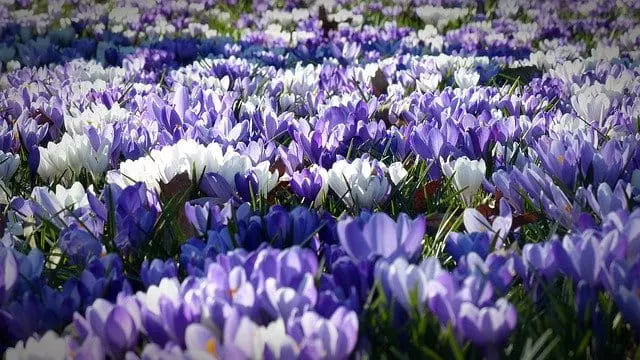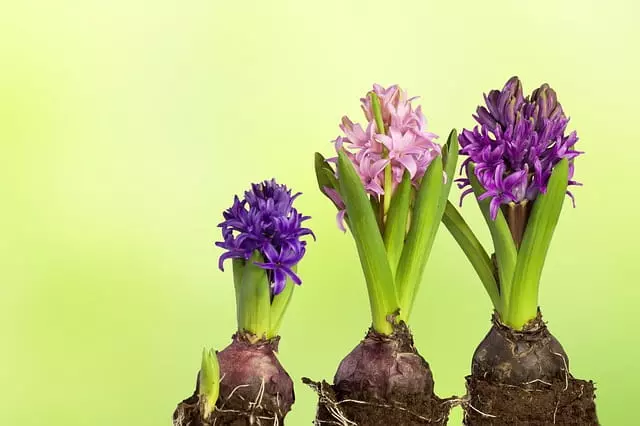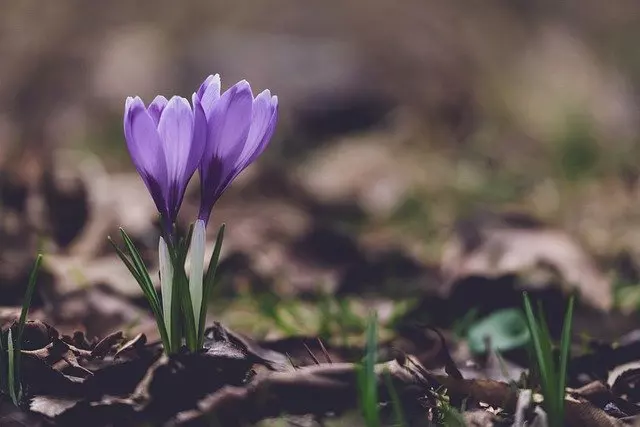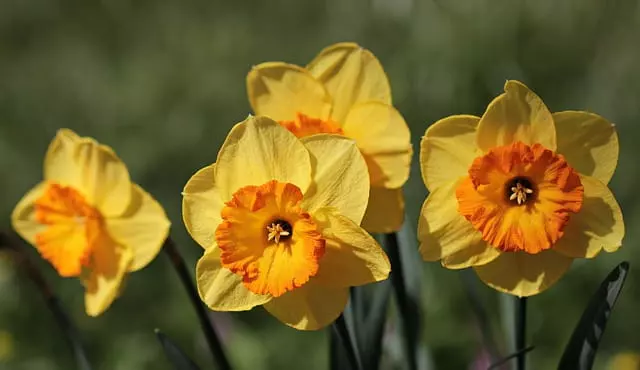Fall bulbs are the first to bloom when spring arrives. So, you may be wondering why they are called fall bulbs?
The answer is simple, they are called fall bulbs because fall is the time when they are planted.
Some gardeners and gardens where to buy bulbs, also call them winter bulbs, because they need to spend the winter in the ground to complete their life cycle of growth and bloom in spring.
Fall bulbs are very popular, I would say much more popular than spring or summer bulbs.
There are many reasons for this popularity, among them I would highlight the great variety of sizes, flowers, and colors they offer…not to mention that they are a foretaste of spring, after a time when the garden is left very gloomy by winter.
Not all fall bulbs bloom at the same time. Their flowering time is from late winter to late spring.
This staggered flowering depends on the variety, the size of the bulb, and its flower. In gardening it allows us to make real games of contrasts, using various colors of flowers and creating different areas of attention, over an extended period.
Table of Contents
Types Of Fall Bulbs
There is a wide variety of bulbs that can be planted in fall, although there are some of them that we could consider as the “star bulbs”:

Tulips
There are about 150 different species of tulips, with an innumerable number of hybrids and cultivars (about 5,000 different ones) obtained through genetic improvement.
The most common are the garden tulips (Tulipa gesneriana) in their different colors: white, red, yellow…
Over time, some real beauties have emerged, which are worth “trying” in the garden, such as the Rembrandt or parrot tulips.
Learn more about How to Plant Tulip Bulbs Step by Step.
- Multi Colors in spring
- EASY & SIMPLE
- Plant now and enjoy in spring
Daffodils
As with tulips, the current cultivars are innumerable, although they are classified into 11 different groups.
Their most common colors are white and yellow, with different heights and flower sizes.
Some can become naturalized in the garden, emerging year after year without the need to raise them, although their flowering tends to diminish.
Hyacinths
The main product of hyacinths (and of many bulbs) in the Netherlands, where we can find thousands of types, although with only three common species.
They produce red, blue, white, or yellow flowers, presented around a very fragrant flower spike.
- Fragrant Hyacinth Mix 12 bulbs/Pack
- Perennial in Zones 4 - 8
- Size 15/16 cm
Iris
Irises get their name from the “rainbow”, about the great variety of flower colors in which we can find iris bulbs.
The most common and the one you will find for sale is the Germanic iris, very easy to grow and propagate in the garden. There are four other very common species: xiphiun, flroentina, pallida and variegata, although the genus comprises about 200 different species.
- Plant in full sun to full shade/Great florist quality cut flower/Deer and critter resistant
- Dutch iris hybrids grow from bulbs that can be planted in fall or spring and are often grown as annuals
- Bulb Size: 7/8 cm/Exposure: Full sun to partial shade/Blooms: Late Spring/Plant Time: Fall & Spring
Crocus
Crocuses are among the smallest fall bulbs in the garden…I personally love them, but you have to be very careful where you choose to plant them: they need to be in a very visible place, so as not to miss their bloom.
There are more than 80 different species of crocus, of which about 30 are cultivated. The best known of all is the one that produces the famous saffron, the crocus sativus.
Snowdrop, Galanthus
Native to cold, damp forests, today we can enjoy a good number of garden varieties.
They bloom very early, at the end of winter (snowdrop) or early spring. Usually offer small white hanging flowers, with a mottled green inside their petals.
They are very easy to naturalize in the garden, although they require specific care.
- Snowdrops with 15 Bulbs Per Pack
- Perennial in Zones 3-7
- Bulb Size 5/6 cm
Tips For Planting Fall Bulbs
Bulbous plants are perennials, we can enjoy them for years … but they require certain care that other plants do not need, in return, they offer us a spectacular flowering in early spring, which usually lasts several days in the garden.
Most perennial garden plants can be multiplied, some by cuttings (roses, hydrangeas…), others by sowing their seeds, but with bulbs, we hardly have to do anything, since their multiplication is spontaneous.
By following these tips, you will have a beautiful bulb garden that will bloom year after year:

Plan And Choose the Varieties of Fall Bulbs You Are Going to Plant
To obtain a spectacular result, it is very important to plan well before planting the bulbs.
There are species of bulbs that complement each other very well, even that can bloom at the same time or in a staggered way, as we like.
For example, the combination of daffodils, tulips, and hyacinths can look great.
Care must always be taken to plant correctly, as I discuss below.
Prepare The Planting Site
Fall bulbs, even spring bulbs, are not too demanding in terms of nutrients, although if we add good compost to the soil where we are going to plant them, they will be grateful for it.
The most important thing about the planting site is that it is loose soil with good drainage.
If the chosen place accumulates water, we will need to improve it by adding a mixture of sand and compost, so that it is much lighter and the bulbs can develop well.
Too much water could cause the bulbs to rot. This situation should be avoided at all costs.
Another aspect to consider is that the chosen location should be sunny, as well as protected from the wind.
Some of the fall bulbs offer very long and flexible stems, which could be blown over by a gust of wind. It would be sad to miss the bloom because of poor planning.
Check The Quality of Fall Bulbs
Whether you have bought fall bulbs or they come from your garden, before planting them you should check that they are in perfect condition.
There are two ways to check that the bulbs are in good condition: visually and by touch.
Visually check that there is nothing suspicious, such as bumps, dark areas, or any other defect that would lead us to suspect that they are not in good condition.
They must be firm to the touch. If they are soft it means that they have begun to rot, if we plant them we will not get anything, the bulb will eventually deteriorate in the soil.
We recommend these bulbs: Tulips, Daffodil, Hyacinth, Iris, Crocus, and Snowdrops. These are all quality bulbs that we recommend from our own experience.

Plant The Bulbs Correctly
Earlier I told you about the importance of a good planting design so that we have an adequate combination of colors or blooms…all at the same time, staggered…etc.
But it is equally important to pay attention to the depth of planting, and the distance between bulbs.
There are two rules to follow to know the planting depth and distance between bulbs, and they have to do with their size.
- To know the depth at which to plant a bulb, its diameter must be considered.
- The depth has to be between two and three times its size. A bulb measuring 1.5″ (4 cm) in diameter, has to be buried at a depth of between 3″ and 5″ (8 and 12 cm).
- For the planting distance between bulbs, follow the same rule: between two and three times their diameter.
Other tips that may come in handy, so that your bulb planting is perfect:
- Plantings should be done in groups so that once they bloom the result is more natural. Use odd groups: 1, 3, 5, 7, 9 bulbs…avoid planting in even groups, in nature, it is more common to find odd numbers.
- Look at the bulb, always place the bulb with the roots downwards and the bud upwards, make sure they are always in a vertical position.
Protect Fall Bulbs from Frost
All fall bulbs need to feel the cold to grow, but if it is intense, some more delicate varieties, originating in more southern countries, can freeze.
There are many tricks to avoid freezing of the soil surface, but the most common is to use some kind of covering such as bark, straw, or compost.
If we have planted them in pots the solution is very simple, put your pot in a place protected from frost.
Watering Fall Bulbs
The last tip has to do with watering fall bulbs.
They are not plants that need excessive watering, on many occasions, they will come through without any watering at all, except when we start planting them.
As we plant in fall, there may still be dry and sunny days, at that time should be watered with caution, avoiding waterlogging.
During the winter we should also make sure that the soil does not become waterlogged, but without watering at all.
When spring arrives we will be surprised with the first sprouts, without having used almost a drop of water.
During the growing season, we will water if the weather is dry and hot.
Remember that at the end of the growing season watering should be suspended, when the aerial part of the bulb dies.







